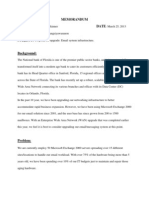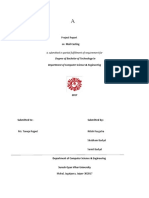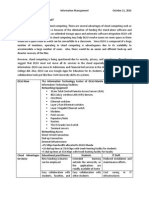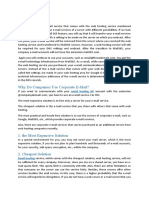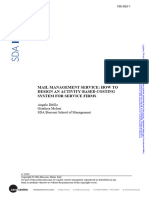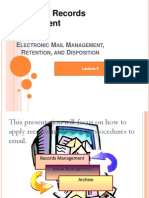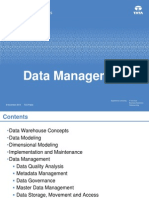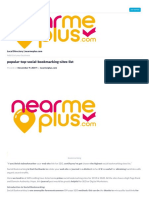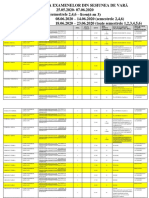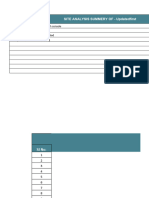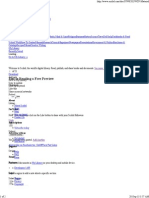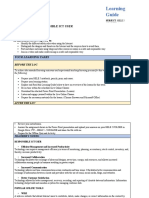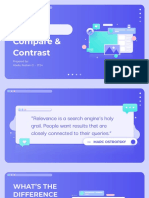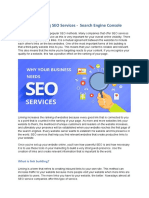Initial Analysis Cloud Computing Email Denver Public Schools Executive Summary: In reviewing the current state of Email
and cloud computing with Matt Cain from the Gartner Group, I discovered range of cloud computing email applications available to the Denver Public Schools. Most options seemed economically advantageous over the Districts current self hosting option. The District could reasonably expect to save in the range of $162K and $972K per year, depending on the cloud computing option chosen. However, changing to a cloud computing option represents a significant shift away from the Districts standard operating model. FERPA compliance is an issue that needs a full review. Additionally, we need to account for the cost of switching in terms of both out of pocket expense and lost productivity. I recommend that we proceed with a thorough total cost of ownership evaluation of the Districts current option. The District should engage both Microsoft and Google and explore their current offering in more detail. A limited trial with several schools may provide insight into the viability of cloud computing for the District and allow for student/teacher collaboration. Cost Comparison Self Hosted Email Typical total cost of ownership for commercial email is approximately $10 per month per user or $120 per year. The assumptions supporting this estimate include
Microsoft Exchange 99.9% reliability Upgrade every 4 years 300 megabytes of storage
To account for a license discount and the lower labor expense for K12, Gartner recommends reducing the total cost of ownership to $8 per month per user or $96 per year. Email in the Cloud Email in a Software as a Service (SaaS) arrangement varies. The range is $5 per user per month to $2.50 per user per month. However, the District will continue to incur an expense of an additional $1 to $2 per month per user. The internal costs cover the expense of experienced technical personnel for directory management and network support. This raises the ongoing total cost of Email SaaS to $7.50 to $4.50 per user per month. The District could also expect to incur an initial $20 per user on boarding cost to include an upgrade of the network to support Email SaaS. The features of Microsofts Email SaaS include:
99.9% reliability with credits for service levels falling below 25 Gigabytes of storage Multi tenant platform
Outlook functionality
Microsoft also offers a free version of Email SaaS to the educational sector; Outlook@EDU or Live@EDU . While Microsoft claims it has 99/9% reliability there are no service level guarantees with the free option. Users typically experience a less aggressive level of support as well. In both case, available email storage for the SaaS option is considerably higher than the self-hosted option.
The cost comparison of three versions of Email SaaS is shown below. Note this does not include a thorough analysis of the Districts email base case costs. In addition, the 13,500 email users are approximate.
HighCost Year1 Ongoing 13,500.00 13,500.00 EmailSaaS LowCost Year1 Ongoing 13,500.00 13,500.00 Free Year1 Ongoing 13,500.00 13,500.00
Users TCO/User/Year District'sEst.TCO MicrosoftsSaaSSubscription Rate/User/Year District'sTotal SubscritionCost District'sSupportCost/User/Year District'sTotal SupportCosts OnBoardingCosts/User/Year OnBoardingCosts Total SavingsoverSelf Hosted/Year PaybackofOnBoardingCosts(Months)
SelfHosted 13,500.00 $96 $ 1,296,000
$ 1,296,000
$ 60 $ 810,000 $24 $ 324,000 $20 $ 270,000 $1,404,000
$60 $ 810,000 $ 24 $ 324,000 $ $ $ 1,134,000
$30 $405,000 $ 24 $324,000 $ 20 $270,000 $ 999,000 $ 297,000 11
$30 $405,000 $ 24 $324,000 $ $ $ 729,000 $ 567,000
$ $ $ 24 $324,000 $ 20 $270,000 $594,000 $702,000 5
$ $ $ 24 $ 324,000 $ $ $ 324,000 $ 972,000
$(108,000) $162,000 20
Assumptions: HighCostEmailSaaSis$5/user/monthwithaDistrictSupportCostof $2/user/month LowCostEmailSaaSis$2.50/user/monthwithaDistrictSupportCostof $2/user/month FreeassumesaDistrictsupportcostof $2/user/month
Security Concerns: Microsoft claims their platform is FERPA compliant, although the definition remains unclear. Most, if not all, inadvertent or intentional disclosure of student information to those who do not have an educational need of the information, lies outside the control of the email system. In Gartner analysis there is little technical difference between the level of security between a selfhosted email system and Email SaaS. Other Technical Considerations: Microsofts current multi-tenant platform for both the high cost and low cost options reside on the Microsoft Exchange 2007 architecture. It currently does not scale and will not support 13,500 users. The new Microsoft Exchange 2010 architecture will support a user population the size of the Districts. Microsoft plans to release 2010 in the second quarter. Given the nature of the release, the District should plan the new version of MS Exchange for the end of the year. Ironically, the free service Microsoft offers the educational market at no cost is on the 2010 Microsoft Exchange Architecture. It will support 13,500 users. The solution described above assumes a multi-tenant architecture. Microsoft does offer a dedicated Email SaaS. It is immediately scalable and can support 13,500 users. The cost of
�this service is $6 per user per month. Including the Districts internal support costs of $2 per use per /month. The total cost is equivalent to the self-hosted email base case. Microsoft also offers a Deskless Worker Option. It is browser only access to email, which is essentially webmail. Its current list price is $2 per user per month and it is likely the District could negotiate to $1 per user per month. Web mail limits functionality, particularly its calendaring options. Microsoft is developing a newer version of its webmail product, which more closely resembles Outlook in its functionality. Timeline: The District could expect to take a minimum of six months and more likely a year to implement Email SaaS. For that time period the District will experience overlapping costs of self-hosting and Email SaaS. I would expect this to reduce the year one benefit by 50%. Recommendations
1. Proceed with further analysis of the Districts true email costs and work with Microsoft to develop a true Email SaaS option for the District to consider. In order to provide a fair analysis, this activity must have the full support of DoTS leadership team. 2. Consider exploring Googles options for Email SaaS 3. Consider moving students and teachers to the free email option Microsoft offers. This will allow better collaboration between teacher and student. If the District starts with a single school it may gain experience with the viability of this option for the entire District.






